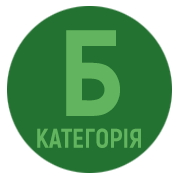EVALUATION OF WATER QUALITY OF THE STUBELKA RIVER ACCORDING TO PHYTOPLANKTON INDICATORS BY
DOI:
https://doi.org/10.32782/naturaljournal.6.2023.13Keywords:
indicator species, species richness, saprobity, biomass, abundance, riverAbstract
Phytoplankton, as the primary link of the trophic chain, quickly reacts to climatic, hydrological, hydrochemical and other changes occurring in the aquatic ecosystem. The immediate reaction of phytoplankton, which is reflected in the restructuring of structural and functional parameters (species richness, ratio of departments, number of species, Shannon’s index, average cell mass, dominants and subdominants), allows the most accurate assessment of water quality and the state of the aquatic ecosystem. The aim of the study was to assess the water quality of the Stubelka River by phytoplankton indicator species. The article analyzes the seasonal changes of the phytoplankton of the Stubelka River and reveals 109 species of algae, represented by 111 intraspecific taxa, 8 divisions, 14 classes, 32 orders, 43 families, and 75 genera. It is shown that the phytoplankton of the Stubelka River is formed by Bacillariophyta (46.8% of the total number of species), Chlorophyta (27.9%), Cyanobacteria (8.1%) and Euglenozoa (8.1%). It was established that the biomass of phytoplankton varies from 0.21 mg/dm3 (October) to 1.04 mg/dm3 (June), and the number – from 714 thousand cells/dm3 (October) to 3424 thousand cells/dm3 (August). The Shannon index varies by biomass from 3.97 b/mg to 4.80 b/mg, and by abundance – from 3.15 b/c to 4.74 b/c. The polydominant structure of phytoplankton prevails in the river. According to the saprobicity index (1.55–2.04), the water of the Stubelka River varies from the α-oligosaprobic to the β-mesosaprobic zone and corresponds to the II-III quality classes (clean, moderately polluted). The core of the phytoplankton of the Stubelka River is formed by benthic and planktonic-benthic species that are slow-flowing in terms of water saturation with oxygen and rheophilicity, and are indifferent in relation to water content and temperature. Indifferents and alkaliphiles predominate in relation to pH. The largest number of autotrophic species that can withstand high concentrations of nitrogen-containing organic compounds was found. According to the level of trophicity, mesoeutrophic species make up 41%. Species-indicators of organic water pollution (according to the Watanabe system) are mainly represented by eurysamples (moderately polluted waters), and according to the Pantle-Book system (in the modification of Sladecek), the largest number of beta-mesosaprobionts. It was established that the water of the Stubelka River belongs to the III quality class (moderately polluted) in terms of the level of organic pollution.
References
Коротун І.М., Коротун Л.К. Географія Рівненської області: природа, населення, господарство, екологія: навчальний підручник. Рівне, 1996. 380 с.
Методи гідроекологічних досліджень поверхневих вод / за ред. В. Д. Романенка. Київ : ЛОГОС, 2006. 408 с.
Щербак В.І. Методи досліджень фітопланктону. Методичні основи гідробіологічних досліджень водних екосистем. Київ, 2002. С. 41–48.
Щербак В.І., Семенюк Н.Є., Давидов О.А., Ларіонова Д.П. Сучасна характеристика фітопланктону, мікрофітобентосу та фітоепіфітону Канівського водосховища. Повідомлення 1: Таксономічне, екологічне різноманіття та просторовий розподіл. Альгологія. 2023. 33(3). 147–184. https://doi.org/10.15407/alg33.03.147.
Barinova S.S., Klochenko P.D., Belous Y.P. Algae as indicators of the ecological state of water bodies: Methods and prospects. Hydrobiol. Jornal. 2015. 51(6). 3–21. https://doi.org/10.1615/HydrobJ.v51.i6.10.
Barinova S., Romanov R. Charophytes Locality in the Ga’aton River, Lower Galilee, Israel. Journal of Biology and Life Science. 2016. Vol.7. №1. 94–109. https://doi.org/10.5296/jbls.v7i1.7815.
Barinova S.S., Bilous O.P., Tsarenko P.M. Algal indication of water bodies in Ukraine: methods and perspectives. Haifa, Kiev: University of Haifa Publisher, 2019. 367 p.
Bilous O.P., Wojtal A.Z., Ivanova N.O., Burova O.V., Barinova S., Maystrova N.V., Polishchuk O., Curtean-Bănăduc A., Tsarenko P.M. Indication of Long-Term Changes of Algae Communities in a Hydrologically Transformed Estuary Sasyk, Black Sea, Ukraine. Water. 2023. 15. 2078. https://doi.org/10.3390/w15112078.
Eliasz-Kowalska M., Wojtal A.Z., Barinova S. Influence of Selected Environmental Factors on Diatom β Diversity (Bacillariophyta) and the Value of Diatom Indices and Sampling Issues. Water. 2022. 14. 2315. https://doi.org/10.3390/w14152315.
Guiry M.D., Guiry G.M. AlgaeBase. World-wide electron. publ. Nat. Univ. Ireland, Galway. 2023. [Електронний ресурс]. URL: https://www.algaebase.org (дата звернення: 15.01.2023).
Oksiyuk O.P., Davydov O.A., Karpezo Yu.I. Microphytobenthos as bioindicator of state of aquatic ecosystems. Hydrobiol. Jornal. 2011. Vol. 47(1). 72–85. https://doi.org/10.1615/HydrobJ.v47.i1.70.
Pugnetti A., Acri F., Alberighi L., Barletta D., Bastianini M., Bernardi-Aubry F., Berton A., Bianchi F., Socal G., Totti C. Phytoplankton photosynthetic activity and growth rates in the NW Adriatic Sea. Chemistry and Ecology. 2004. Vol. 20. №6. P. 399–409. https://doi.org/10.1080/02757540412331294902.
Shelyuk Yu.S. Phytoplankton of the Ukrainian Polissia River Ecosystems. International Journal on Algae. 2023. 25 (2). P. 139–156. https://doi.org/10.1615/InterJAlgae.v25.i2.30.
Sereda T.N. Phytopotamoplankton of River Systems: Retrospective Review of Investigations, Search for Methodic Approaches. Hydrobiol. Jornal. 2016. Vol. 52(6). 33–42. https://doi.org/10.1615/HydrobJ.v52.i6.40.
Sladeček V. System of water quality from the biological point of view. Ergebnisse der Limnol. 1973. V. 7. №1/4. P. 1–218.
Van Dam H., Mertens A., Sinkeldam J. A coded checklist and ecological indicator values of freshwater diatoms from the Netherlands. Netherlands Journal Aquatic Ecology, 1994. 28. P. 117–133.





